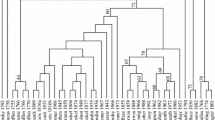Abstract
Scholars in the humanities often have to account exhaustively for the structure of large masses of data. Tree-diagrams implemented by means of suitable computer programs can be of considerable assistance in achieving a cohesive representation of the data. This paper discusses the respective merits of the two main approaches to tree representation and introduces a new method based on the use of unrooted trees. After a detailed examination of the topological properties of such trees, two algorithms are described. The second part of the paper consists in practical applications of the method of tree representation to a corpus of contemporary English poetry. Several sets of data made up of both lexical and grammatical items (adjectives, modals, auxiliaries and personal pronouns) have been submitted to the method. The findings are assessed in terms of their heuristic value in the light of modern linguistic theory and compared with the results obtained by means of more traditional statistical procedures.
N. X. Luong is a doctor of Sciences and a lecturer at the University of Nice. He is conducting research on algorithms in the field of discrete mathematics. He has, among other things, created several algorithms for the representation of data in the form of non-hierarchic trees.
Similar content being viewed by others
References
Barthélemy, J. P. and N. X. Luong. “Représentations arborées des mesures de dissimilarités.” Statistique et Analyse des Données 11, 1 (1986), 20–41.
Benveniste, E. Problèmes de linguistique générale. 2 vols. Paris: Gallimard, 1966, 1974.
Benzécri, J. P. L'analyse des données. 2 vols. Paris: Dunod, 1973.
Buneman, P. “The Recovery of Trees from Measures of Dissimilarity.” In Mathematics in Archeological and Historical Sciences. Ed. F. R. Hodson, D. G. Kendall, and P. Tautu. Edinburgh: University Press, 1971, 387–95.
Buneman, P. “A Note on Metric Properties of Trees.” Journal Comb. Theory (B), 17 (1974), pp. 48–50.
Colonius, H. and H. H. Schulze. “Tree Structure for Proximity Data.” British Journal of Mathematical and Statistical Psychology, 34 (1981), 167–80.
Day, W. H. E. Analysis of Quartet Dissimilarity Measures Between Undirected Phylogenetic Trees. Technical report, Université de Montréal, (no date).
Day Lewis, C. Collected Poems. London: J. Cape and The Hogarth Press, 1954.
Dobson, A. J. “Unrooted Trees for Numerical Taxonomy.” Journal of Applied Probabilities, 11 (1974), 32–42.
Estabrook, G. F. and C. Meacham. “How to Determine the Compatibility of Undirected Character State Trees.” Mathematical Biosciences, 46 (1979), 251–56.
Estabrook, G. F., F. R. McMorris, and C. Meacham. “Comparison of Undirected Phylogenetic Trees Based on Subtrees of Four Evolutionary Units.” Systematic Zoology, 22, 1 (1985), 193–200.
Farris, J. S. “On Comparing the Shape of Taxonomic Trees.” Systematic Zoology, 22, 1 (1973), 50–54.
Halliday, M. A. K. An Introduction to Functional Grammar. London: Arnold, 1985.
Juillard, M. L'expression poétique chez Cecil Day Lewis, vocabulaire, syntaxe, métaphore. Etude stylostatistique. Geneve: Slatkine, 1983.
Juillard, M. “A Quantitative Approach to Semantic and Morphosemantic Fields in a Literary Work.” ALLC Journal, 1 and 2 (1985), 14–23.
Juillard, M. “Linguistique et linguistique quantitative.” In Proceedings of the XIIIth ALLC International Conference Norwich. Geneve: Slatkine, 1988.
Luong, N. X. “Voisinage lâche, score et famille scorante.” Cahiers du S.U.R.F., 2, Université de Besançon.
Luong, N. X. Méthodes d'analyse arborée. Algorithmes, applications. Doctorat d'Etat dissertation, Université de Paris V, 1988.
McMorris, F. R. “Axioms for Consensus Functions on Undirected Phylogenetic Trees.” Mathematical Biosciences, 74 (1985), 17–21.
Patrinos, A. N. and S. L. Hakimi. “The Distance Matrix of a Graph and its Tree Realization.” Quarterly Applied Mathematics (1972), 255–69.
Phipps, J. P. ”Dendrogram Topology.” Systematic Zoology, 20, 3 (1971), 306–08.
Sattath, S. and A. Tversky. “Additive Similarity Tree.” Psychometrika, 42, 3 (1977), 319–45.
Waterman, M. S. and T. F. Smith. “On the Similarity of Dendrograms.” Journal of Theoretical Biology, 73 (1978), 369–81.
Wittgenstein, L. Philosophische Untersuchungen. Oxford: Blackwell, 1953.
Zaretskii, K. “Constructing a Tree on the Basis of a Set of Distances Between Hanging Vertices.” Upekki Math. Nauk., 20 (1965), 90–2. (In Russian.)
Author information
Authors and Affiliations
Additional information
Michel Juillard teaches English at Nice University and is a member of the Unité de Recherche 9 of the CNRS. He obtained a Doctorat d'Etat in English linguistics from Paris VII University. His publications include L'Expression poétique chez Cecil Day Lewis, vocabulaire, syntaxe, métaphore, étude stylostatistique (Geneva and Paris: Slatkine, 1983), and many more articles on linguistics and stylistics. His present research centers on language variation, text linguistics and comparative stylistics.
Rights and permissions
About this article
Cite this article
Juillard, M., Luong, N.X. Unrooted trees revisited: Topology and poetic data. Comput Hum 23, 215–225 (1989). https://doi.org/10.1007/BF00056144
Issue Date:
DOI: https://doi.org/10.1007/BF00056144




